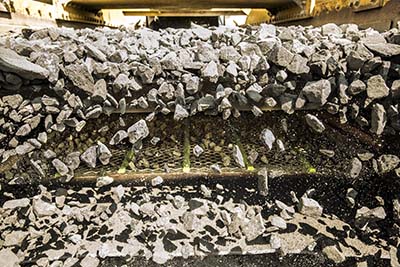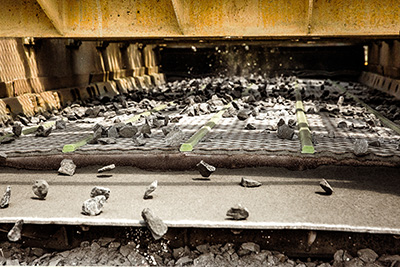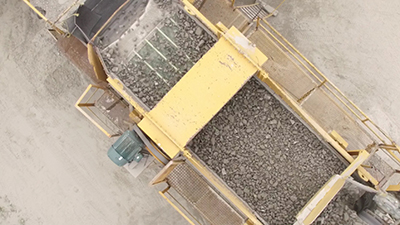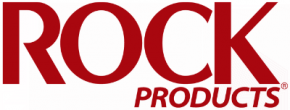Choosing The Right Screen Media Can Improve Production And Solve Screening Problems.
By Lars Bräunling
With proposed infrastructure programs being discussed to offset the economic impacts of COVID-19, aggregate materials could see a spike in demand. This progression can lead to increased profits for mineral processing operations.
However, maximizing efficiency to capitalize on this opportunity requires the right equipment. It is critical that operations evaluate their process flow and equipment selection routinely to ensure they are using the best tools for the job. Screen media selection, for example, is an often-overlooked factor that can have a significant impact on overall efficiency.
Though relatively cheap compared to the rest of the equipment in a quarry or mine, it could be argued that media has as much impact on productivity and material quality as the vibrating screen. And it is important that operations give screen media as much buying consideration as they do the vibrating screen itself.
For this reason, a number of factors should influence the choice of screen media. Certainly, cost is a consideration, but it shouldn’t be reduced to purchasing price versus wear life. A full cost analysis needs to include labor cost for change-outs and cleaning, loss of production during downtime, media performance – tons produced, for example – and indirect factors like crusher relief.
Thinking only in terms of dollar value can be shortsighted and end up costing an operation more in the long run. The operating environment – including material characteristics and recurring screening problems – should also be considered. From there, look at different media types to find out what fits best, and learn proper installation and maintenance to ensure long term success.
Look at the Application
 |
 |
 |
Selecting the proper screen media for an application first involves examining the screening plant and any issues surrounding it. Start with taking a look at the material being processed to get an idea of what the media needs to stand up against. Consider the drop height, material size, abrasiveness, weight and volume.
Naturally, the more impact the material will have on the screen media, the higher durability that media should have, at least at the impact point. Also, abrasive material – such as granite – calls for resistant screen media, such as polyurethane or high-vibration wire media. Likewise, top sizes of 10 in. or larger demand a more durable screen, including options like double wire screens, perforated plate or rubber.
Take a look at the flow of material. A visual check or belt cut of the crusher feed belt is an effective way to see if there is saleable rock being sent to the crusher. This could be the result of carryover or because the deck capacity is exceeded. The solution may be adjusting the cut, improving capacity or fixing screening problems like blinding or pegging with alternative screen media.
Now, examine the longevity of the existing screen media. Is it wearing much faster than expected? Note the area of the deck with the most wear as that could indicate a need for a stronger media. Spot wear by looking at wire diameter and whether wires are developing a flat top, especially in high wear zones like the feed end and center area of the deck. Look for rounded openings if using synthetic media such as rubber or polyurethane.
In addition to the deck itself, the pile of discarded screen media can be a good area to look for insight into screening problems. Make note of things like broken wires, wear areas, pegging or blinding to pinpoint problems on your decks. Any of these can lead to material contamination and downtime, making them a significant cause for concern. Also, black marks on the underside of polyurethane or shiny undersides of wire can indicate a poor fit of your screen media and may point to a need for additional personnel training.
Finding Better Screen Media
Depending on the operation, an hour of downtime could cost hundreds of dollars in lost production. That makes choosing a screen media that maximizes uptime and efficiency even more critical.
Perforated steel plate and heavy rubber panels are, almost by definition, the most durable options. Rubber can be effective for screening material with a top size larger than 12 in. or for openings bigger than 4 in., but tends to be more susceptible to pegging. Perforated plate is an acceptable option for applications requiring a durable screen media with a lot of open area, but is often noisier and heavier, which can cause issues. Both also typically have less open area than wire alternatives.
Woven wire cloth has been the traditional option for a long time for a reason. It is relatively inexpensive and effective. But there are a number of advanced options available that offer more durability, throughput and versatility. And purchasing a traditional woven wire design based solely on price may end up costing more in terms of wear life and more frequent change-outs.
Synthetic modular media, such as polyurethane or rubber, is typically known for its long wear life and ability to reduce noise levels, but it isn’t without its own challenges. This type of media typically has less open area than wire screens, leading to decreased throughput. This, in turn, also reduces the capacity of bottom decks because the material takes longer to make its way down. Also, operations using synthetics must keep a close eye on the panel openings. Openings tend to wear by rounding out, making it necessary to regularly check that the panels are still the correct size and not letting out of spec material through.
Both synthetic screen media and traditional woven wire are very rigid and rely on the vibrating screen to do most of the heavy lifting. The static movement of the screens limits vibration to 800 or 900 cycles per min. In most cases, this does not hinder the screen media from achieving adequate production and throughput, but it is not fully using screening equipment either. And often it results in common issues, such as blinding and pegging.
High vibration screen media offers a wear life compromise between synthetic and woven wire, and often provides the most performance benefits. The media features high strength wire bonded by polyurethane or rubber strips to hold individual wires. The wires vibrate independently of one another – within opening size specifications – to amplify the screening process and increase throughput by as much as 40%. Additionally, the vibrations prevent or significantly reduce pegging, blinding and clogging issues, improving product quality and reducing potential downtime.
However, not all high vibration screen media is the same. Most manufacturers don’t customize the media specifically to each application to ensure optimum performance and wear resistance. When properly fitted to an application, high vibration screen media can amplify the work of the vibrating screen with vibrations of 6,000 to 10,000 cycles per min. – up to 13 times greater than traditional, rigid media options. Often the screen media can be modified with thicker or double wires and additional polyurethane to further boost durability.
There are inexpensive options for every style of screen media, but operations should hesitate before choosing them. The lower price often comes with reduced performance and wear life as a result of poor quality with the material, weaving, trimming and hooking process for wire screens or, similarly, poor manufacturing and material with other styles of screen media. The up-front cost will be lower, but lost production and frequent screen replacements will quickly add up.
Only the Best Will Do
Just because a vibrating screen is a much larger investment than a screen media panel doesn’t mean buying considerations shouldn’t be equal. Both components significantly impact material quality and operational efficiency.
Selecting the best screen media involves taking a look at the big picture. While not required, an operation can expedite the decision process with experience-backed recommendations from a screen media OEM or dealer. With infrastructure on the rise, the potential for fewer screening problems, increased uptime and more profit flowing over the screen makes the whole process worthwhile.
Lars Bräunling is the director of product technology at MAJOR.
